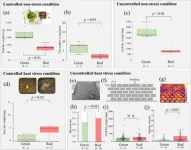(Press-News.org) BIRMINGHAM, Ala. – Lung development in the fetus occurs at low oxygen tension in the womb, but after a very premature birth, the partly developed lungs of the tiny infants experience far greater oxygen tensions even without the prolonged supplemental oxygen that is often required. This can produce well-known disastrous effects on the structure and function of the neonatal lung, causing the serious lung condition of bronchopulmonary dysplasia in high-risk premature infants.
Using a neonatal mouse model, researchers at the University of Alabama at Birmingham have shown that changes in the microbiota of the gut contribute to this dangerous lung injury. The changes occur because supraphysiologic oxygen exposure — 85 percent oxygen versus the normal 21 percent given to the newborn mice from the third to 14th days of life — suppresses expression of the normal host-derived antimicrobial peptides in the small intestine.
Antimicrobial peptides are known to play a key role in regulating intestinal microbiota through host defense against microbes. These small proteins produced by intestinal cells have a broad antimicrobial activity to kill or inhibit the growth of bacteria, fungi and viruses.
The novel finding of reduction of antimicrobial peptides upon exposure of the neonatal mice to supraphysiologic oxygen, in turn, led to altered composition of the intestinal microbiota in the neonatal mice, including increased abundance of bacteria in the genus Staphylococcus, as measured in the terminal ileum of the small intestine, the place where preterm infants are uniquely vulnerable to microbiome-mediated necrotizing enterocolitis.
Significantly, when the UAB researchers, led by Kent Willis, M.D., and Tamás Jilling, M.D., UAB Department of Pediatrics Division of Neonatology, gave supplemental lysozyme to the neonatal mice exposed to supraphysiologic oxygen, the augmented dietary lysozyme robustly altered the ileal microbiome to ameliorate the increase in Staphylococcus that had been seen after exposure to hyperoxia. Lysozyme is the most common antimicrobial peptide produced by the gut, and it is also highly expressed in human breast milk.
The functional consequence of this augmented dietary lysozyme was less lung injury, including improved lung structure and function after hyperoxia exposure in the neonatal mice. The dietary lysozyme also increased the gene expression of multiple antimicrobial peptides in the ileum through an apparent feed-forward mechanism, including a 2.4-fold increase in expression of the mouse lysozyme Lyz1 gene.
To test whether supraphysiologic oxygen directly suppresses antimicrobial peptide production by intestinal epithelial cells, collaborators in the Division of Newborn Medicine, Department of Pediatrics, Boston Children’s Hospital, Harvard Medical School, led by Amy O’Connell, M.D., Ph.D., grew intestinal organoids and exposed them to either hyperoxia (95 percent oxygen) or normal oxygen tension (21 percent) for 24 hours. Intestinal organoids are self-organized, three-dimensional structures derived from intestinal cells and grown in vitro to model the behavior of the original intestinal tissue.
After exposure to supraphysiologic oxygen, these intestinal organoids showed suppression of antimicrobial peptide genes, similar to changes seen in intestines of hyperoxia-exposed mice.
“In summary, we have described a gut-lung axis driven by intestinal antimicrobial peptide expression and mediated by the intestinal microbiota that influences hyperoxia-induced lung injury,” Willis said. “These murine and organoid experiments suggest that antimicrobial peptide expression represents a potential therapeutic target to modulate the intestinal microbiota and the response to lung injury. These results have implications for the clinical management of premature infants at high risk of developing bronchopulmonary dysplasia in neonatal care.”
Co-first authors of the study, “Antimicrobial peptides modulate lung injury by altering the intestinal microbiota,” published in the journal Microbiome, are Ahmed Abdelgawad and Teodora Nicola. Co-senior authors are Willis, Jilling and O’Connell.
Other co-authors are Isaac Martin, Brian A. Halloran, Kosuke Tanaka, Pankaj Jain, Changchun Ren, Charitharth V. Lal and Namasivayam Ambalavanan, UAB Department of Pediatrics Division of Neonatology; and Comfort Y. Adegboye, Harvard Medical School.
A video abstract of the study is available.
Support came from National Institutes of Health grants HL151907, HL156275, HL141652, DK120871, ES027697 and ES031559; the Harvard Digestive Disease Center NIH grant DK034854; the Kaul Pediatric Research Institute at Children’s of Alabama; and the Microbiome Center at UAB.
At UAB, Pediatrics is a department in the Marnix E. Heersink School of Medicine.
END
Antimicrobial peptides modulate lung injury by altering the intestinal microbiota
Researchers have identified a gut-lung axis driven by intestinal antimicrobial peptide expression and mediated by the intestinal microbiota that is linked to lung injury in newborns. These results have implications for the clinical management of premature
2023-10-20
ELSE PRESS RELEASES FROM THIS DATE:
Diagnosis and management of postoperative wound infections in the head and neck region
2023-10-20
“The majority of wound infections often manifest themselves immediately postoperatively, so close followup should take place [...]”
BUFFALO, NY- October 20, 2023 – A new research perspective was published in Oncoscience (Volume 10) on October 4, 2023, entitled, “Diagnosis and management of postoperative wound infections in the head and neck region.”
In everyday clinical practice at a department for oral and maxillofacial surgery, a large number of surgical procedures in the head and neck region take place under both outpatient and inpatient conditions. The basis ...
Brain & Behavior Research Foundation awards $10.2 million in Young Investigator Grants to 150 mental health scientists
2023-10-20
The Brain & Behavior Research Foundation announced it is awarding $10.2 million in Young Investigator Grants to 150 promising early career scientists who are working to identify causes, improve treatments, and develop methods of prevention for psychiatric illnesses that impact millions of people in the United States and around the world.
The 2023 Young Investigators are focused on a broad range of psychiatric illnesses. More than half of the projects are relevant to the study or treatment of depression and schizophrenia. Addiction/substance-use disorders, anxiety, and ...
Contaminants in cannabis and hemp flowers create potential for health risks
2023-10-20
Cannabis use, even for medical purposes, could make some people sick due to harmful fungi that contaminate the plants.
That is the finding of a recently published peer-reviewed journal article, whose authors recommend further study and consideration of changes to regulations to protect consumers, especially those who are immunocompromised. They examined data, previous studies, and U.S. and international regulations related to the cannabis and hemp industry.
The article was published in Frontiers in Microbiology. It was researched and written by Kimberly Gwinn, professor of entomology and plant pathology at the University of Tennessee Institute ...
COVID-19-related jail decarceration did not affect crime in California
2023-10-20
Since 2011, California has significantly reformed its criminal justice system, reducing the size of its prison population, with no effect on violent crime and only marginal impacts on property crime statewide. The COVID-19 pandemic furthered decarceration as the state reduced state prison and jail populations to slow the spread of the virus. Concerns emerged that releases under the auspices of COVID mitigation harmed public safety. A new study explored this notion and found no consistent relation between COVID-19-related jail decarceration and violent or property ...
Challenging prehistoric gender roles: Research finds that women were hunters, too
2023-10-20
It’s a familiar story to many of us: In prehistoric times, men were hunters and women were gatherers. Women were not physically capable of hunting because their anatomy was different from men. And because men were hunters, they drove human evolution.
But that story’s not true, according to research by University of Delaware anthropology professor Sarah Lacy, which was recently published in Scientific American and in two papers in the journal American Anthropologist.
Lacy and her colleague Cara Ocobock from the University of Notre Dame examined the division of labor according to sex during the Paleolithic era, approximately 2.5 million to 12,000 ...
Felix Parra Diaz elected a fellow of the American Physical Society
2023-10-20
Felix Parra Diaz, the head of the Theory Department at the U.S. Department of Energy’s (DOE) Princeton Plasma Physics Laboratory (PPPL), has been elected a 2023 Fellow of the American Physical Society (APS). This honor recognizes scientists who have helped advance physics by contributing original research, showing how to apply physics to the worlds of science and technology, or exhibiting excellence in physics teaching.
Parra Diaz was cited for “transformational contributions to the theory ...
ESMO Manifesto - Translating scientific evidence into effective public health policy
2023-10-20
ESMO announces Public Policy Manifesto on key issues for oncology to bring to European institutions after 2024 elections.
Studies presented at the ESMO Congress 2023 set new standards of care across a wide range of tumour types.
Madrid, Spain, 20 October 2023 – Evidence is building up that strong political action has the potential to tackle two of our era’s biggest challenges: climate change and the increasing burden of cancer on society. At the opening press conference of the ESMO Congress 2023 taking place 20-24 October in Madrid, Spain, a slew of studies marking meaningful ...
Massachusetts Life Sciences Center awards $4.3 million to MBL to support imaging innovation
2023-10-20
WOODS HOLE, Mass.—The Massachusetts Life Sciences Center (MLSC) has awarded $4.3 million to the Marine Biological Laboratory (MBL) to expand its imaging capabilities to serve the Massachusetts life sciences community.
The grant, which will be used to procure two state-of-the art microscopes capable of increased resolution and advanced technology, such as milling for the reconstruction of samples in 3D, was announced at a press conference on October 18 at the grand opening of a new incubator, the Massachusetts Biomedical Initiatives (MBI).
MBL Director of Research Anne Sylvester ...
Does urbanization trigger plant evolution?
2023-10-20
Urbanization and human activities have transformed a significant proportion of the land on Earth, resulting in the formation of urban environments. These urban environments are man-made habitats that often impose several selective pressures on their inhabitants. A key characteristic of such environments is the presence of impermeable, heat-retaining surfaces created using brick, stone, asphalt, and concrete. Notably, these surfaces form urban heat islands, i.e., regions with elevated surface temperatures. An unexpected result of heat stress ...
Why do some men not produce sperm?
2023-10-20
KANSAS CITY, MO—October 20, 2023—Millions of couples worldwide experience infertility with half of the cases originating in men. For 10% of infertile males, little or no sperm are produced. Now, new research from the Stowers Institute for Medical Research, in collaboration with the Wellcome Centre for Cell Biology at the University of Edinburgh, is shedding light on what may be going wrong in the process of sperm formation, leading to potential theories on possible treatments.
“A ...
LAST 30 PRESS RELEASES:
Air pollution exposure and birth weight
Obstructive sleep apnea risk and mental health conditions among older adults
How talking slows eye movements behind the wheel
The Ceramic Society of Japan’s Oxoate Ceramics Research Association launches new international book project
Heart-brain connection: international study reveals the role of the vagus nerve in keeping the heart young
Researchers identify Rb1 as a predictive biomarker for a new therapeutic strategy in some breast cancers
Survey reveals ethical gaps slowing AI adoption in pediatric surgery
Stimulant ADHD medications work differently than thought
AI overestimates how smart people are, according to HSE economists
HSE researchers create genome-wide map of quadruplexes
Scientists boost cell "powerhouses" to burn more calories
Automatic label checking: The missing step in making reliable medical AI
Low daily alcohol intake linked to 50% heightened mouth cancer risk in India
American Meteorological Society announces Rick Spinrad as 2026 President-Elect
Biomass-based carbon capture spotlighted in newly released global climate webinar recording
Illuminating invisible nano pollutants: advanced bioimaging tracks the full journey of emerging nanoscale contaminants in living systems
How does age affect recovery from spinal cord injury?
Novel AI tool offers prognosis for patients with head and neck cancer
Fathers’ microplastic exposure tied to their children’s metabolic problems
Research validates laboratory model for studying high-grade serous ovarian cancer
SIR 2026 delivers transformative breakthroughs in minimally invasive medicine to improve patient care
Stem Cell Reports most downloaded papers of 2025 highlight the breadth and impact of stem cell research
Oxford-led study estimates NHS spends around 3% of its primary and secondary care budget on the health impacts of heat and cold in England
A researcher’s long quest leads to a smart composite breakthrough
Urban wild bees act as “microbial sensors” of city health.
New study finds where you live affects recovery after a hip fracture
Forecasting the impact of fully automated vehicle adoption on US road traffic injuries
Alcohol-related hospitalizations from 2016 to 2022
Semaglutide and hospitalizations in patients with obesity and established cardiovascular disease
Researchers ‘listen in’ to embryo-mother interactions during implantation using a culture system replicating the womb lining
[Press-News.org] Antimicrobial peptides modulate lung injury by altering the intestinal microbiotaResearchers have identified a gut-lung axis driven by intestinal antimicrobial peptide expression and mediated by the intestinal microbiota that is linked to lung injury in newborns. These results have implications for the clinical management of premature






